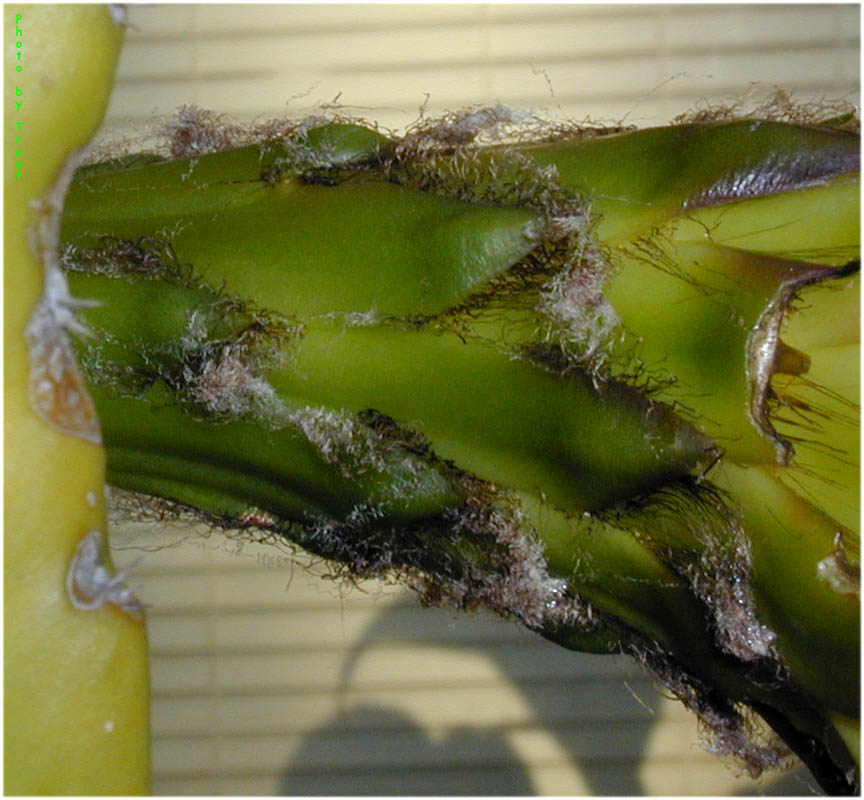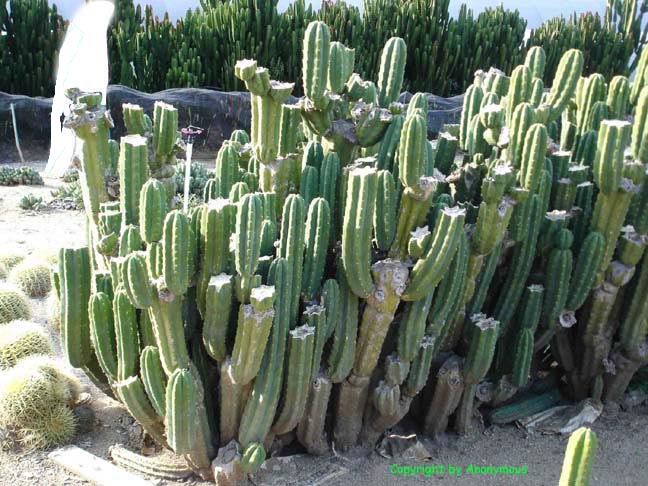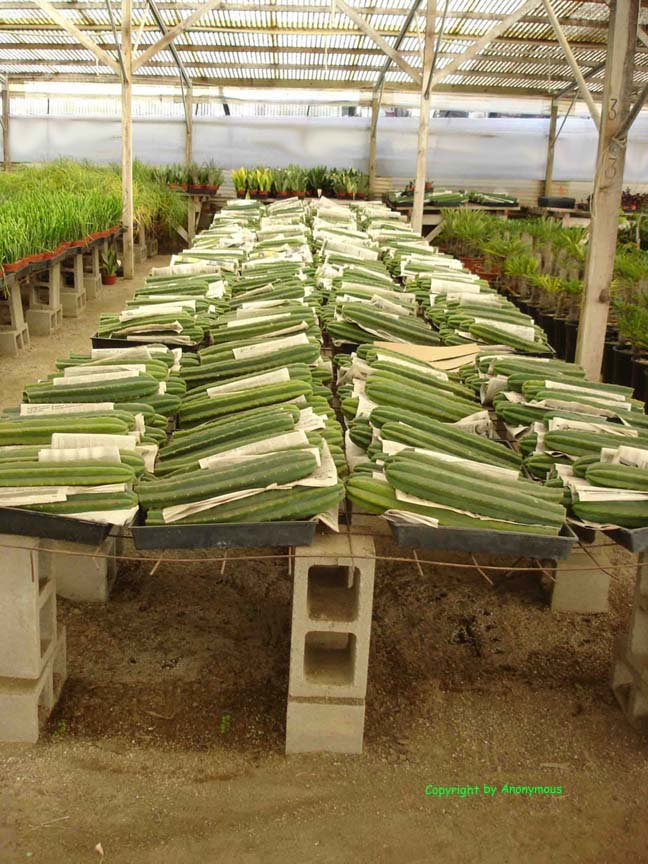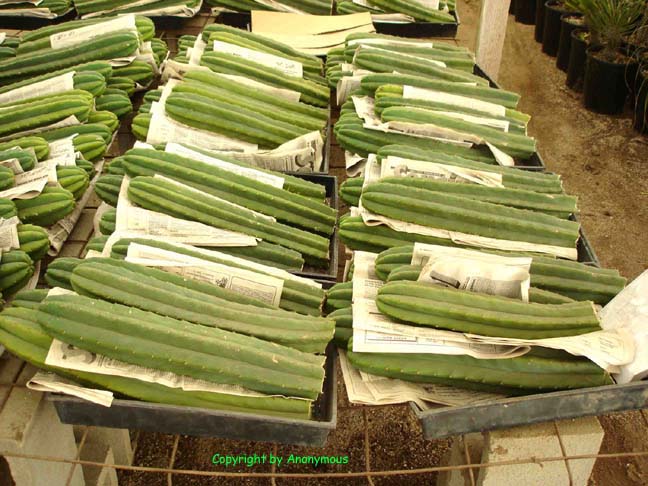A comparison of the flowers from a few assorted Trichocereus species that appear to be closely related to each other based on their simple morphology. (click to return to the smaller views):
Copyright © by Keeper Trout
"More than YOU want to know?
A comparison of the flowers from a few assorted Trichocereus species that appear to be closely related to each other based on their simple morphology. (click to return to the smaller views):
Copyright © by Keeper Trout
There are many forms of Trichocereus bridgesii (aka Echinopsis lageniformis) in the wild and represented in horticulture. The images below represent just a few of those many.
Anderson appears to have expanded the range of Trichocereus bridgesii well into Peru and applied it to the Trichocereus huanucoensis at Huanuco which can reach 7 (or more) inches in diameter. This was done with no inclusion of any additional details so we can only wonder at Anderson’s reasoning as to why he felt it was closer to Trichocereus bridgesii than Trichocereus pachanoi or Trichocereus peruvianus.
Cuttings on the top left came from Huanuco, Peru.
Photograph is copyright by Kitzu.
I was told that its spines fell off during transportation.
Image above on the right & the next pair below are H 1294 at the Huntington.
These were obtained as 8 seedlings from Curt Backeberg, which they received the 9th of February 1932.
Both tips of the next tips are of aff. bridgesii (H 79960 at the Huntington)
A Trichocereus bridgesii grown from Friedrich Ritter’s seeds that were obtained by UC in 1953.
Although most of these are in cultivation everything depicted above is originally from wild collections.
Some views of Trichocereus bridgesii in Bolivia.
Next are offerings from two different witches markets in Bolivia that appear to be for tourists.
While some of the tips shown are thus far the closest cacti we have yet seen to the pachanot, this is misleading as they also typically to show the presence of some much longer spines which on these cuttings have been removed.
A couple of oddly stout Trichocereus bridgesii in horticulture. The one on the right was purchased as Trichocereus pachanoi in New Mexico.
Copyright © by Keeper Trout
except where indicated otherwise.
One of at least several forms expressed by seedlings of the purported Trichocereus peruvianus huancabamba is shown below. This one was grown by Oasis from seeds that Kermit had obtained from Mesa Garden.
Under some conditions of growth the pachanot can look rather similar.
Copyright © by Keeper Trout
A comparison of the flowers from a few assorted Trichocereus species that appear to be closely related to each other based on their simple morphology. (click here for a larger version):
Copyright © by Keeper Trout
Three images shared by Michael Smith of short-spined Trichocereus pachanoi growing in Ecuador.
Spine length can be extremely variable so it surprisingly can often be a feature that does not help much with species assignment in this area. (Trichocereus peruvianus similarly expresses a range of spination from short to long.)

Smith’s observations
with excerpts from some published descriptions.
Topic 1: Backeberg’s clone
Topic 2: pachanoi compared to pachanot.
Additional material to ponder:
Copyright © by Keeper Trout
The images on this page show pachanot production in a large wholesale commercial nursery operation in southern California. These are produced in bulk as pristine high-quality new-growth tips that are sold as unrooted but healed cuttings to many retail nurseries. Their customers typically then root them, sometimes then growing them out into various sizes of nursery pots, and then resell them as their nursery stock. I’ll bet that many readers in the USA have actually seen these people’s material in their local big chain home improvement centers.
If this was hybrid, whether produced by a horticulturalist’s hands or encountered in the wild, it would be hard for any professional cactus grower to not recognize it as a serious potential money maker due to its features of not just having a growth rate driven by hybrid vigor but possessing large, showy and pleasantly fragrant flowers that occurred reliably and abundantly in almost any mild to moderate temperate climate, its habit of freely branching into multicolumn specimens, a highly favorable responsiveness and toleration to cuttings being taken, and its high water tolerance with no moderate drought and freeze hardiness.



Photographs © copyright by Anonymous;
reproduced with permission by Trout’s Notes
Smith’s observations
with excerpts from some published descriptions.
Topic 1: Backeberg’s clone
Topic 2: pachanoi compared to pachanot.
Additional material to ponder:
H 79960 Trichocereus aff. bridgesii growing in a private collection in Monrovia, California.
The plant shown above was obtained from the Huntington (with their permission and assistance).
Smith’s observations
with excerpts from some published descriptions.
Topic 1: Backeberg’s clone
Topic 2: pachanoi compared to pachanot.
Additional material to ponder:
Copyright © by Keeper Trout
Cochabamba, Bolivia holds at least one fascinating Trichocereus pachanoi form.
These are apparently propagated by a convent.
Photographs are copyright by Dani; reproduced with permission.
My THANKS to Michael S. Smith for noticing these
and for obtaining permission for their inclusion!
A closer view of a spiny Trichocereus pachanoi cultivated at Quito, Ecuador.
Both long and short spined forms of pachanoi are common in Ecuador (similar to the picture in Peru). It has been proposed that the short spined versions were developed by human selection but as far as I can tell this is entirely still speculative.
Image copyright by Hubbie Smidlak 2008;
reproduced with permission by Trout’s Notes
More pachanoi at Quito, Ecuador
pachanoi at Vilcabamba, Ecuador
pachanoi in Peru
pachanoi in Bolivia
Smith’s observations
with excerpts from some published descriptions.
Topic 1: Backeberg’s clone
Topic 2: pachanoi compared to pachanot.
Additional material to ponder:
